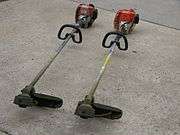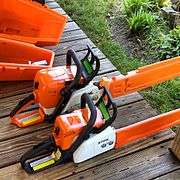Stihl
Andreas Stihl AG & Company KG (/stiːl/ (![]()
 Stihl logo | |
| Private Corporation | |
| Industry | Forestry equipment, Landscape maintenance |
| Founded | 1926 |
| Founder | Andreas Stihl |
| Headquarters | Waiblingen, Germany |
Key people | Nikolas Stihl (chairman of Stihl Holding AG & Co. KG Eva Stihl (vice chairperson) |
| Products | Industrial chainsaws, string trimmers, cultivators, cut-off saws, leaf blowers, construction tools, edgers, pole pruners, augers/drills & protective apparel |
| Revenue | €3.782 billion (2018)[1][2] |
Number of employees | 17,122 (2018)[3][4] |
| Website | Stihl.com |
Company history
Andreas Stihl designed and hand built his first chainsaw in 1926. The saw was electrically powered, and weighed about 64 kg. The Stihl name soon became popular, and also became synonymous with professional grade chainsaws and soon became the number-one selling chainsaw company in the world, a title that the company retains to this day. Stihl growth was slow initially, as the chainsaws came to the market about the same time as the Great Depression; with manpower cheap, and old two-man saws proven, there was no need for power saws. The early saws were very heavy, and often needed two men to operate them. Some outfits had a wheeled generator which had a power cord to run to the electric saw. Stihl saws were used by the Wehrmacht, particularly in Eastern Europe and Russia, where timber was cut for defensive positions.
In the mid-1970s Stihl expanded the company by building manufacturing plants in Brazil and in the United States. Much of the increased demand came from the construction and landscaping markets. Along with the professional markets, Stihl designed a number of home-use equipment, like blowers, line trimmers, edgers, and chainsaws. In 2008, the newest Stihl production facility opened in Qingdao, China.[7] In December 2008, Stihl acquired the carburetor producer Zama to safeguard the supply and to enter a new business segment with growth potential.[8]
During the 70s while building chainsaws, Stihl entered the weed-trimmer\brush-cutter market contracting a Japanese company as their supplier for several years until Stihl had their own model to build themselves.
1992 saw the acquisition of the Austrian Viking brand.
Stihl Subsidiaries
Incorporated in Delaware, Stihl Inc. is the US subsidiary of Stihl International GmbH and is based in Virginia Beach, Virginia. Construction of the facilities there began in 1974. Along with the manufacturing facilities, there are also warehouses and administration buildings at the 150-acre complex. Stihl Inc. employs almost 2,000 employees on 2 million square feet of buildings.
Andreas Stihl Ltd was founded in 1978 in the United Kingdom.
Product Evolution
After the war, the availability of cheap, strong aluminum, better designs, and more powerful engines meant that the Stihl saw came into its own. The name of the saw that was proving itself was called the Stihl Lightning perhaps with a model designation of 07S.
Having established a foot hold in America the reputation of dependability propelled Stihl to the top of the market. Many improvements to design during the 1970s led the "chainsaw" to become a homeowner tool. Automatic chain oiling. anti-vibration handles, electronic ignition, chain brakes are some of them. Not only was the stronger aluminum a component but injected magnesium was used for even greater strength and lightweight.
In the early 1970s there were few models of Stihl chainsaws available, with a model number related to cubic inches, rare for a German design. There was a standard & a heavy duty (the 040 & 050) with super saws of 070 & 090. Improvements led to the 041 & 051 and with anti-vibration came the 041AV. A new style lighter-weight saw was introduced with the 030AV, the 031AV etc. The reputation of the 020AV among fire fighters and tree trimmers was so good that demand for the saw continued even after mass-production ceased .
Four employees would take all the parts and assemble them by hand averaging 10 saws per day. However, the saws did command upwards of $600 while other small saws were selling for a third of that. The new style of the 031 was made into an 045 that out-cut the 051 so the 051 was improved to an 075 (about 110cc). The 045 was hopped up to an 056 with a Magnum and a Magnum II before it was discontinued. Also, there was an 08S (56cc) which was a chainsaw but also a powerhead, removable bar & chain, that would power tools such as brush cutter, post hole digger, and cut-off saw. The experience with injection molding was applied to a new material, plastic. The plastic injection system at the factory in Virginia Beach is run round the clock so the mold does not clog. Batches of plastic plugs are tested for quality before use with weather chamber that simulates hot & cold and saws are dropped from a height to see if bending or breakage occurs.[9]
Product gallery
 Stihl gasoline-powered trimmers. Mid-1990s model FS74, left, and 2004 model FS80R, right.
Stihl gasoline-powered trimmers. Mid-1990s model FS74, left, and 2004 model FS80R, right. Stihl gasoline-powered chainsaws: MS 170 (foreground), MS 290 Farm Boss (background)
Stihl gasoline-powered chainsaws: MS 170 (foreground), MS 290 Farm Boss (background)- Stihl MS 170
References
- Facts and Figures about the STIHL Group
- STIHL_AnnualReport2018_EN.pdf
- Facts and Figures about the STIHL Group
- STIHL_AnnualReport2018_EN.pdf
- "Stihl USA FAQ". Retrieved 2018-03-12.
- "STIHL Corporate Culture" (PDF). Archived from the original (PDF) on 2015-09-24. Retrieved 2015-05-06.
- "Shandong Provincial Government Delegation visited STIHL Qingdao". Archived from the original on 2012-04-26. Retrieved 2013-11-01.
- STIHL AG & Co. KG. "Stihl press release". Retrieved 24 October 2016.
- personal experience in the industry